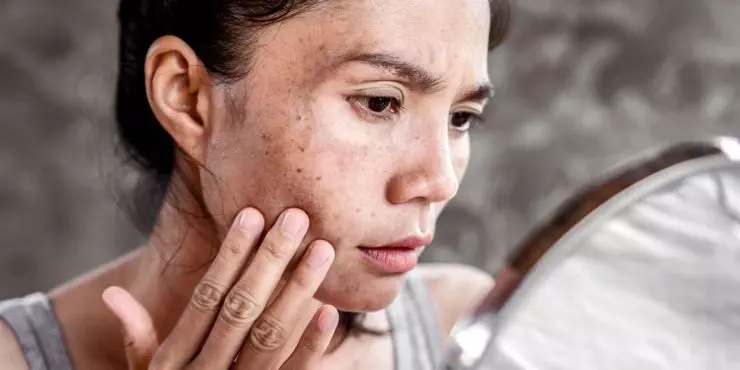
As we age, we may notice changes in our physical stamina, our ability to tolerate certain foods and even spots and discoloration of the skin. While it’s common to develop sun spots, moles and other normal discoloration of the skin, these sometimes can be an indicator of something more serious like melanoma or other types of skin cancer. Let’s delve into the causes, treatment options, and prevention strategies for these spots and when to see a doctor. By gaining a better understanding of these skin blemishes, you can make informed decisions to maintain healthy and youthful-looking skin.
Understanding Sun Spots and Other Skin Issues
Sun Spots Causes and Characteristics
Sun spots, also known as solar lentigines or liver spots, are dark patches that appear on the skin as a result of prolonged exposure to the sun's ultraviolet (UV) rays. These spots typically appear on areas frequently exposed to sunlight, such as the face, hands, arms, and shoulders. Over time, UV radiation triggers the overproduction of melanin, leading to the formation of these brown or tan spots.
Aging Spots Causes and Characteristics
Common aging spots, often referred to as age spots or lentigines, are similar to sun spots in appearance but can arise without excessive sun exposure. While UV radiation plays a role in their development, age spots are primarily associated with natural aging processes. As we age, the skin's ability to regenerate and distribute melanin becomes less efficient, resulting in the accumulation of pigment in certain areas. These spots are commonly found on areas exposed to the sun, but they can also appear on less exposed areas like the back or legs.
Moles Causes and Characteristics
While very normal, moles can be an indicator of something more serious like skin cancer. Moles are caused by several factors that include genetics, sun exposure, hormonal changes, and congenital factors.
Moles should be monitored regularly and generally to determine if a mole is normal it should fit into the following descriptions:
- Asymmetry: Normal moles are usually symmetrical, meaning one half mirrors the other half. If a mole has irregular or uneven borders or appears asymmetric, it could be a cause for concern.
- Border: A normal mole typically has a well-defined and smooth border. Moles with blurred, jagged, or irregular borders may require evaluation.
- Color: Most normal moles have a uniform color, which can range from light brown to dark brown. Suspicious moles may have uneven coloring, variations in shades of brown, black, red, white, or blue.
- Diameter: Normal moles are usually small, with a diameter of 6 millimeters (about the size of a pencil eraser) or less. Moles that are larger than this may warrant closer examination.
- Changes: Pay attention to any changes in a mole over time. Rapid growth, changes in size, shape, color, or texture, as well as the development of symptoms like itching, bleeding, or crusting, are potential signs of concern.
Freckles Causes and Characteristics
Freckles, like moles, are very common and can be caused by several factors which include; genetics, sun exposure, having light skin and hair, and age. Freckles are generally harmless and do not present much risk of being a sign of something more serious.
Treatment Options

Treatment Options for Sun Spots and Aging Spots:
- Topical creams and lotions containing ingredients like hydroquinone, retinoids, or kojic acid. These can be purchased over the counter or be given as a prescription. Consult your doctor before starting these.
- Chemical peels performed by dermatologist, which involves applying a chemical solution to the skin to exfoliate the outer layer. This treatment helps reduce the appearance of spots and promotes the growth of new, healthy skin.
- Laser treatments target the pigmented areas with concentrated light, breaking down the excess melanin and reducing the appearance of spots. Multiple sessions may be required for optimal results.
Treatment Options for Moles and Freckles:
- Monitoring if moles or freckles are normal in appearance, stable, and do not exhibit any worrisome features.
- Cosmetic camouflage using products such as concealers or foundations, can help temporarily minimize their visibility.
- Laser treatment can be used to lighten or remove certain types of pigmented lesions, including some moles and freckles.
- Cryotherapy involves freezing the mole or freckle with liquid nitrogen. This freezing process destroys the pigmented cells, causing the lesion to gradually fade or fall off.
- Surgical removal if a mole or freckle exhibits concerning features or if there is suspicion of skin cancer. This procedure involves cutting out the lesion and stitching the skin back together. The tissue is then sent to a lab for further examination.
Prevention
Prevention Strategies for Sun Spots, Aging Spots, Moles and Freckles:
- Sun protection: Apply broad-spectrum sunscreen with a high SPF to exposed areas daily, even on cloudy days. Wear protective clothing, such as wide-brimmed hats and long sleeves, and seek shade when the sun's rays are strongest.
- Sun Avoidance: Minimize sun exposure during peak hours, typically between 10 a.m. and 4 p.m., when UV radiation is most intense.
- Regular Skin Checks: Monitor your skin for any changes in spots, moles, or discoloration. Early detection is crucial in identifying potential skin concerns.
- Hydration and Antioxidant-rich Diet: Maintain a healthy diet with plenty of fruits and vegetables, as they contain antioxidants that help protect the skin from free radical damage. Stay hydrated to support overall skin health.
Get Checked Today
If you have noticed spots, bumps or moles that are new or may fall into the category of abnormal it’s time to get checked. Get any suspicious spots checked early to potentially catch any more serious issues early. Schedule your visit today.